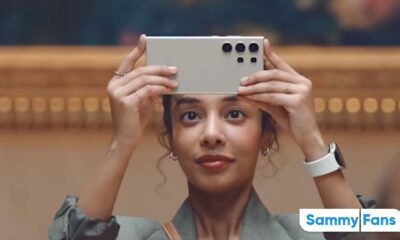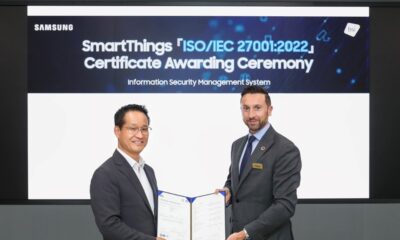News
Samsung launched 110-inch MicroLED TV, features zero bezels and 4K resolution

Samsung announced the launch and pre-sale of the 110” Samsung MicroLED beginning today in Korea. Unlike other displays currently in the market, the Samsung MicroLED self-emitting LED display technology provides excellent color vibration and brightness.
In 2018, Samsung unveiled its first MicroLED display in the form of “The Wall” – a system of professionally configurable modules that can be installed. For the first time, Samsung is offering the MicroLD experience in the traditional TV format with the new 110” MicroLED.
The modular counter, the new 110” MicroLED model is pre-built, which makes installation and setting efficient – providing excellent video, audio, and smart capabilities outside the box.
Over the past year, user interest and demand for large screen TVs have been growing rapidly. With the launch of the 110” MicroLED, Samsung offers the next generation TV display with a comfortable visual experience.
Also Read: Samsung adds Google Assistant feature to its smart TVs

Innovative Engineering Delivers Next-Level Picture Quality
Ultra-large screen fans ask for the best image quality with vibrant colors and excellent resolution. Samsung’s 110” MicroLED micrometer-sized LED lights are used with Samsung’s latest engineering innovations to reduce backlights and color filters used in traditional displays.
Instead, it illuminates itself, producing light and color from its own pixel structure. It represents 100% DCI and Adobe RGB color gamut and captures a wide range of color gamut images taken with high-quality DSLR cameras.
It offers stunning, life-like colors and accurate brightness from the display’s 4K resolution and 8 million pixels.
The 110” MicroLED also has a processor that is compatible with display capacity. Its newest micro AI processor delivers excellent 4K HDR content – resulting in bright, powerful, and realistic image quality optimized for every scene.
Immersive Design and Premium Audio
When you turn on the 110” MicroLED, thanks to its 99.99% screen-to-body ratio. The black matrix and bezel are completely removed from the display – leaving the screen alone to give users the best content experience.
The 110’’ MicroLED will be available globally in the first quarter of next year following today’s unveiling in Korea. For more information about the 110’’ MicroLED, please visit the Samsung office site.
News
Here’s why Google Messages replaced Samsung Messages on Galaxy devices

Samsung’s latest foldable phones come with Google Messages by default. The company has now revealed the reason behind this move on Galaxy devices. Samsung says Google Messages replaced Messages to foster RCS adoption.
According to AndroidAuthority, a source explained Samsung’s decision to switch to Google Messages as the default messaging app. The recently released Galaxy Z Flip 6 and Z Fold 6 come with Google Messages with RCS enabled by default.
Looks like promoting Google Messages on Galaxy devices will boost RCS adoption. Samsung Messages isn’t already installed on newer phones. However, one’s stopping you from getting it on your Galaxy from the Galaxy Store.
While many apps support the RCS feature, Google Messages offer the best user experience. Making it a default messaging app is an effort to boost the adoption of RCS tech. Apple is also preparing to bring RCS chat functionality to iMessage for iPhones.
What Samsung source said:
- Even if messaging apps follow the RCS standard, the availability may be limited depending on which app the other party uses. That’s why we decided to make Google Messages the common messaging platform, allowing Galaxy users to communicate more freely. This also enables a messaging app to respond to changes of the RCS standard more quickly and efficiently.
Previously, Samsung devices launched in the US came with two messaging apps. This time, the company has removed the Samsung Messages. During the first setup, users are notified that Google Messages is the default messaging application.
News
Samsung SmartThings gets ISO 27001 certified

Samsung SmartThings gained the international standard ISO/IEC 27001:2022 certification. The company has officially announced this major development in its global connected living platform.
SmartThings received ISO/IEC 27001:2022 certification for information security management systems. Certification reiterates that the SmartThings Cloud operates per international standards.
To be certified, a company has to meet the standard across a total of 123 detailed items, including policies for information security, access control for information assets, and incident response.
SmartThings receiving the ISO 27001 certification is the result of our sustained focus on the protection of information in a hyper-connected world with exponentially increasing intelligence.
Seungbum Choi, Executive Vice President and Head of Device Platform Center at Samsung Electronics said “this is just another step in our drive to fortify the platform’s security. We will continue to find new ways to ensure that SmartThings’ personalized services are provided even more safely.”

BSI Prez says that they have recognized that the operation capability and security level of Samsung SmartThings is excellent. It will further boost trust in the SmartThings platform and strengthen business competitiveness.
ISO 27001 is the leading global standard for ISMSs and was established by the International Organization for Standardization. It provides companies with guidance to manage the risks to information assets systematically and achieve information protection goals.
News
Dr.diary fuels Samsung Health with glycated hemoglobin algorithm
Samsung Health app integrated the Dr.diary (Doctor Diary) glycated hemoglobin feature. The blood sugar management platform announced the launch of its glycated hemoglobin estimation functionality on Samsung’s Health application.
According to ETNews, Dr.diary announced the integration of a glycated hemoglobin level feature in Samsung Health. Galaxy users will now be able to check the estimated glycated hemoglobin level provided by Doctor Diary.
To activate the feature, Health app users will have to permit certain conditions of data in the Blood Sugar service. It is worth noting that glycated hemoglobin is a key figure for diabetes diagnosis, which users will find worth using in the Health app.
Established in 2017, Dr.diary is a blood sugar management platform. It analyzes and predicts the changes in glycated hemoglobin using its own algorithm. Earlier this year, the firm secured a patent for “glycated hemoglobin estimation based on blood sugar data table.”
Song Je-yoon, CEO of Doctor Diary, said, “With our predicted glycated hemoglobin level prediction algorithm being installed in Samsung Health, more people will be able to recognize their glycated hemoglobin level and manage their health more efficiently.”

Glycated hemoglobin (HbA1c) is a standardized numerical value of the percentage of hemoglobin, such as hemoglobin, which has been glycated by glucose. Glycated hemoglobin reflects the average blood sugar level over the past 2-3 months.
Samsung Health (with Wear OS Galaxy Watch) users can conveniently check their estimated glycated hemoglobin level within the app and use this information to manage their blood sugar levels through diet and exercise.












